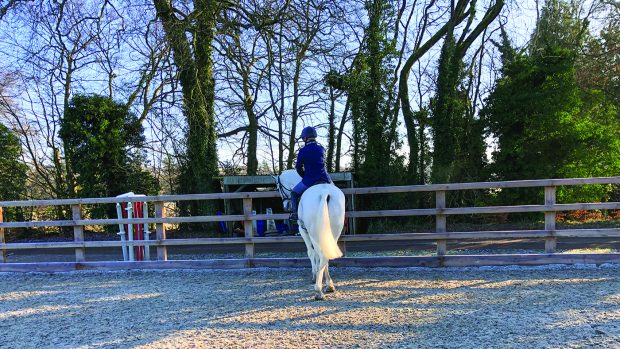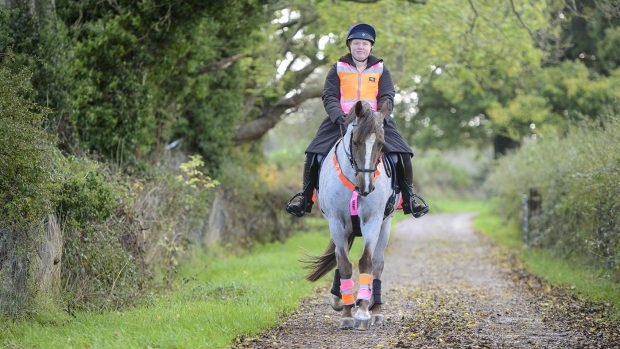Jason Webb of Australian Horse Training is a renowned UK-based horse trainer with a passion for starting young horses, solving equine problems and teaching riders of all abilities and ambitions develop and strengthen the partnership they have with their horses. Here Jason gives a H&H forum user advice on how to prevent her horse from planting on the spot while out hacking
Q: “I need some help. I have been riding for 50 years and suspect I am now being ‘had’ by a pony. I have a 13-year-old Haflinger mare that was backed and lightly ridden as a five year old but not ridden afterwards as I bought her to be a companion to my other horse. I started riding her again in March last year, just hacking three or four times a week to keep her weight down. As expected, she was a bit of a piglet at first — absolute pain to mount, bargey and so on, but she has got over all of that and is now pretty well mannered and hacks out nicely, with or without others.
“Except… over the past couple of months she has started having issues when we get to certain bridges on our regular ride along an abandoned railway line. The bridges have the same surface as the main ride, i.e they are not concrete or anything nasty. Basically, she stops. She does not attempt to turn around, back up, rear or take any other evasive action. She simply will not go forwards. If I approach the bridge at trot, she slows to a walk about 50–100 metres back from the bridge (irrespective of my Thelwell-kicking-child impressions) and then stops something like 20 metres before the bridge.
“I have never managed to get her to take a step forward from when she stops:
• Not through squeezing or kicking.
• Not (to my shame as I don’t like hitting) through giving her a good couple of slaps behind the girth and on the bum with a stick, no response whatsoever.
• No reaction if I simply sit there and wait, although my max for that was 15 minutes. She just happily stands there and rests a hoof.
If I get off and lead her she grudgingly allows herself to be pulled along until I remount once we are on the bridge and then off she merrily goes with no problem.
“There are two bridges she particularly ‘dislikes’ and will always stop at unless I am riding with someone else or if I am out with my dog and the dog goes across in front. She occasionally refuses to move off from my leg if I stop and talk to walkers, but I can eventually persuade her to move after a few seconds. She has only once stopped at a bridge on the way home, hence my belief that I am being had, big time.
“I suspect I am now probably just reinforcing this behaviour by not being able to get past it. It’s not the end of the world, but it’s a pain and I don’t want it to get worse. Do you have any ideas please?”
A: Riding technique is really important but this can’t be taught in an article… But I’ll do my best to give you some tips! Some people are powerful riders and some are not, when I say that I don’t mean forceful, I mean they are very efficient at transferring energy from to themselves to their horse. In dressage it’s the equivalent of contact. When riding young or remedial horses, it is the ability to convince your horse to follow your lead through the energy you put through your seat and reins. This does sometimes mean using a whip, but using a whip without being convincing/powerful/positive/confident/decisive through your other aids won’t amount to much as it has to be timed right, as you are finding out.
Continued below…
Related articles:
Ask yourself, are you kicking all the time?
If you are you are, then you are just desensitising your horse to the forward cue and basically becoming a nag, they just switch off and some will plant. Sometimes we don’t realise just how much we are kicking or nudging the horse as we ride and an honest friend can check this for you as lot of riders I meet are not even aware they are doing it and swear they aren’t but they are! It’s become second nature to them as it has to their horse to not listen.
To overcome this, ride forward through your core and not the lower leg. Inevitably your horse will stop without that constant tap along. When they do, use everything you’ve got to get them to going again. As soon as they are going forward go back to riding through your core. So in short, I expect they will stop when you stop asking for forward, but they will soon learn not to do this and instead to keep going and to wait to be asked to stop. Your horse will want to do the easiest thing and so they will soon realise it’s more effort for them to have to get going again each time they stop of their own accord and that their reward for maintaining forward is actually you not nagging them.
Another trick I use when a horse stops in a situation like yours and they won’t move forward for love nor money is move them left or right. This can unlock their feet very effectively. It’s important in this situation that any step forward is rewarded by allowing yourself and your horse to stop and have a 10 to 30 second rest. The more effort they put in with their movement the longer the rest and reward. This can take some time but it’s baby steps in the right direction and you will find that giving them this time to reflect when they have done something well will help them realise what they got right, where they found the release from you and they will soon start moving forward more willingly!
Practise riding with purpose
I find riding with more purpose makes a big difference to your riding technique and your horse’s response to you. Try doing some mounted games type races, ride off the yard at a trot, giving your horse a fast canter/gallop up a field (if you are able) or doing some of my www.yourhorsemanship.com challenges as this are all about having a purpose in our riding.
So why does riding with purpose help?
The delay between your aid and your horse’s response is a grey area where negativity can creep in and your ability to control your horse becomes more difficult. Riding like this will help you to get rid of that delay. This is why sometimes, when I ask a horse to walk off and they are a bit slow, I ride for all I’m worth for one to three seconds. Some might consider this a bit over the top, but I know what happens if I allow this behaviour to manifest and soon they respond at my first “ask” so that I don’t have to follow up with a “tell” which is much better for them in the long run and me as a rider.
Hope this helps!
Jason
For more information on Jason Webb visit his online training base Your Horsemanship, where you can learn a foundation in horse training with online lessons in groundwork, starting, and ridden fundamentals





